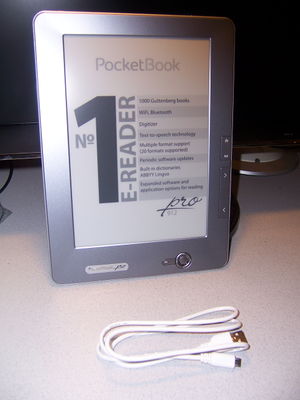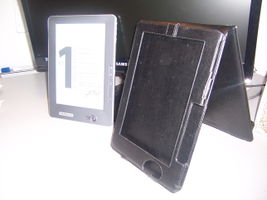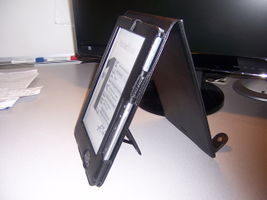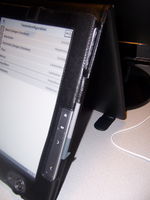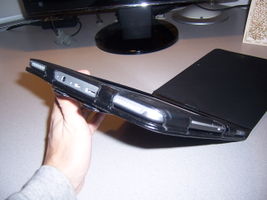Difference between revisions of "Ebook Reader"
From Blue-IT.org Wiki
(→The device) |
(→The device) |
||
| Line 26: | Line 26: | ||
== The device == | == The device == | ||
| − | I like the [http://www.pocketbook-int.com Pocketbook] e-ink device (there are others!) of the 9xx-series because of its excellent hardware quality, the big screen, it's intuitive handling through the hardware buttons and touchscreen. But unlike on other devices you can use either | + | I like the [http://www.pocketbook-int.com Pocketbook] e-ink device (there are others!) of the 9xx-series because of its excellent hardware quality, the big screen, it's intuitive handling through the hardware buttons and touchscreen. But unlike on other devices you can use either one or both input types, you will not be forced to use one (imagine you are on the road an loose the stylus). You can use it for right hand or left hand usage, the hardware buttons switch correspondingly. Very good. |
But the most important thing is: the Linux firmware is completely open source. Surely it it possible to hack even a Kindle, but all Pocketbooks make it easy to add software and compile it on your own. Without any restrictions, despite the one that you need the skills to do so ;) The software might be better on other devices, but this is a matter of time. Development cycles for hardware are short term (speaking in years) and I like to use my device more than 2 years in terms thinking of [http://en.wikipedia.org/wiki/Electronic_waste electronic waste]! A time when others throwed a away their KiXXX-devices, because there is no way to fix a serious software bug. I know what I am talking about, using and working with Linux and IBM/Lenovo machines (which are not the nicest ones, but you can always repair them easily) for years now. | But the most important thing is: the Linux firmware is completely open source. Surely it it possible to hack even a Kindle, but all Pocketbooks make it easy to add software and compile it on your own. Without any restrictions, despite the one that you need the skills to do so ;) The software might be better on other devices, but this is a matter of time. Development cycles for hardware are short term (speaking in years) and I like to use my device more than 2 years in terms thinking of [http://en.wikipedia.org/wiki/Electronic_waste electronic waste]! A time when others throwed a away their KiXXX-devices, because there is no way to fix a serious software bug. I know what I am talking about, using and working with Linux and IBM/Lenovo machines (which are not the nicest ones, but you can always repair them easily) for years now. | ||
Revision as of 14:28, 7 January 2012
Contents
[hide]A word in advance about e-ink readers
An e-ink device is for reading eBooks in natural and bright lightning conditions!
It is not and should not be a
- Tablet PC
- Organiser
- Email checker
- Web-Browsing device
- Multimedia device for playing music, whatching photos, ...
It mainly is for reading TEXT, taking notes, navigation with table of contents, searching text documents ...
Why? In a time, when "multitasking" is the no. one buss word it is time to have a device for only one purpose: just reading! I don't want to deal with other tasks, when reading a book. I want to leave my page open and don't think about an empty battery. I want to lay it aside, reopen it later like a book - fast, uncomplicated and without worrying.
The e-ink technology has its limitations, but it biggest advantage is
- natural reading in natural and bright light conditions
- no refresh rate of the display is good for the eyes
- very (!) long battery life (weeks of reading possible)
A description of the device that I bought I already made in this thread (in language german) at mobileread) and here more actual. A Youtube video you can find here.
PocketBook Pro 912
--Apos 03:41, 7 January 2012 (CET)
The device
I like the Pocketbook e-ink device (there are others!) of the 9xx-series because of its excellent hardware quality, the big screen, it's intuitive handling through the hardware buttons and touchscreen. But unlike on other devices you can use either one or both input types, you will not be forced to use one (imagine you are on the road an loose the stylus). You can use it for right hand or left hand usage, the hardware buttons switch correspondingly. Very good.
But the most important thing is: the Linux firmware is completely open source. Surely it it possible to hack even a Kindle, but all Pocketbooks make it easy to add software and compile it on your own. Without any restrictions, despite the one that you need the skills to do so ;) The software might be better on other devices, but this is a matter of time. Development cycles for hardware are short term (speaking in years) and I like to use my device more than 2 years in terms thinking of electronic waste! A time when others throwed a away their KiXXX-devices, because there is no way to fix a serious software bug. I know what I am talking about, using and working with Linux and IBM/Lenovo machines (which are not the nicest ones, but you can always repair them easily) for years now.
The disadvantages are:
- hight price,
- slower hardware (500 MHz, 256RAM)
- the display is not "state of the art" (type Vizplex, not one of the never Pearl displays)
But I can honestly say: it suffices my needs completely. Anyway: you need enough light (which is essential) and a good e-document (large enough fonts, best sans serif). But that is something you always should be aware of when reading - take care of your eyes!
There is always a reason to look abroad for something "better" and there is always challenge. What will restrict us now will be resolved in the future.
After a couple of weeks now of extensive usage I can say that reading documents on an e-ink device is really much more relaxed, than reading on a computer monitor. What I like most is, that I am reading in natural light conditions, the more light the better. An e-ink device - at least at time of writing this - is nothing for a café inside with shimmering light. But reading outside, in even the sun, at home with a good reading lamp - that's a lot of fun. What make me really smile is: I am carrying around all my literature and I don't have to worry about power consumption (if one does not use the wireless LAN or Bluetooth function extensively).
Unfortunately there are some drawbacks, especially when it come on PDF-files (see the article Ebook Conversion. You need at least an 10'' e-ink (which are the biggest ones at the time of writing) to be able to read them. I am talking about A4-size books, most of the time you need to crop them or you have to read them in landscape mode of the reader, half a side by half a side.
I am looking forward when 14'' or 15'' devices will come to the market at real book size. With weight under 400 grams, good display resolutions and fast hardware. Until then, we have to deal with the high prices, slower hardware. But as always with new technologies, then we have to live with this compromises for a certain amount of time.
Picture gallery
Videos
Short intro
This video shows some features of the reader. The quality is not that good, due to the use of an old digital camera. If you like to sponsor me a new one: feel free ;) By the way, this is my first Youtube video ever made and uploaded ;)
{{#widget:YouTube|id=OksWzxZ1knU}}
DIY bookend with Velcro stripes
Warning: removing the Velcro stripes can damage your cover! So think before you glue!
{{#widget:YouTube|id=d7iEEzTH4I0}}
Fbreader software
Tried the fbreader180. The features are really good, but the integration with the PocketBook 912 Pro is disappointing:
- No TTS
- No Notes
So I stay with the stock, but a little buggy fbreader and will wait until it becomes more mature.
